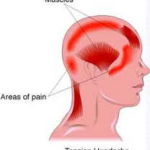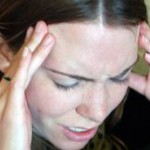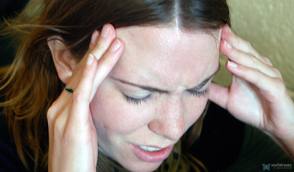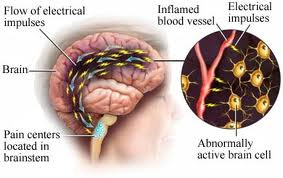According to the National Headache Foundation, over 45 million Americans suffer from chronic, recurring headaches and of these, 28 million suffer from migraines. About 20% of children and adolescents also have significant headaches.
What Are the Types of Headaches?
There are several types of headaches. In fact, 150 diagnostic headache categories have been established!
Below is a list of the most common types of headaches.
 Tension headaches: Also called chronic daily headaches or chronic non-progressive headaches, tension headaches are the most common type of headaches among adults and adolescents. These muscle contraction headaches cause mild to moderate pain and come and go over a prolonged period of time.
Tension headaches: Also called chronic daily headaches or chronic non-progressive headaches, tension headaches are the most common type of headaches among adults and adolescents. These muscle contraction headaches cause mild to moderate pain and come and go over a prolonged period of time.
About 50% of patients attending a doctor with a headache will have Chronic Daily Headache. Many different classifications have been used to describe Chronic Daily Headache including medication misuse headache, hemicrania continua and transformed migraine. Chronic Daily Headache Type is characterised by a combination of background, low-grade muscle contraction-type symptoms, often with stiffness in the neck, and superimposed migrainous symptoms. Patients might have had migraine in the past and experienced a difficult patch of high frequency headache, prompting them to increase their analgesic intake. These analgesics can then lead to a worsening of the chronic headache pattern resulting in analgesic dependence.
In the United Kingdom, the most commonly implicated drugs are those containing codeine but all simple analgesics and ergotamine compounds have been implicated. In recent times, the triptan class of drugs has also been reported to cause chronic headache, although it is our opinion that this situation is uncommon. However, the medication probably does not actually cause the condition. It is more likely that patients achieve transient relief from this class of drug, leading them to repeat dosing. Risk factors appear to include not only a past history of migraine and high analgesic intake, but also injuries to the head and neck, such as a whiplash injury. The aim of management in Chronic Daily Headache Type is to return patients to their original acute headache pattern, which requires a combination of treatments including:
- Identify Stressors in your life and reduce sources of stress ( SPI © test).
- Physical measures in the neck and shoulder areas (eg, exercises or formal physiotherapy, acupuncture or     osteopathy or chiropractic).
- Avoidance of analgesics and ergotamine to break the cycle.
- Use of effective, regular prescription medicines, usually drawn from the antidepressant or antiepileptic groups.
Migraines: The exact causes of migraines are unknown, although they are related to blood vessel contractions and other changes in the brain as well as inherited abnormalities in certain areas of the brain. Migraine pain is moderate to severe, often described as pounding, throbbing pain. They can last from four hours to three days and usually occur one to four times per month. Migraines are associated with symptoms such as sensitivity to light, noise, or odors; nausea or vomiting; loss of appetite; and stomach upset or abdominal pain. When a child is having a migraine they often look pale, feel dizzy, have blurred vision, fever, stomach upset, in addition to having the above listed symptoms.
A small percentage of pediatric migraines include recurrent (cyclic) gastrointestinal symptoms, in which vomiting is most common. Cyclic vomiting means that the symptoms occur on a regular basis — about once a month. These types of migraines are sometimes called abdominal migraines.
Trigger Factors For Migraine:
Environmental factors: Build up of tiredness over the working week, emotion and stress (eg, anger), missed meals (hypoglycaemia), smoke, strong odours (eg, perfume, paint), too much/little sleep, weather changes, bright/flashing lights.
Hormonal changes:Hormone replacement therapy (HRT), menstruation, oral contraceptives, pregnancy.
Exercise or exertion: Eye strain, head injury, irregular/no exercise.
Food/ingredients: Alcohol, artificial sweeteners, caffeine, chocolate, cultured dairy products fermented/pickled foods, fruits, mature cheese, monosodium glutamate, nitrates (eg, in cured meats), sugar, sulphites, vegetables, yeast.
 Mixed headache syndrome: Also called transformed migraines, this is a combination of migraine and tension headaches. Both adults and children experience this type of headache.
Mixed headache syndrome: Also called transformed migraines, this is a combination of migraine and tension headaches. Both adults and children experience this type of headache.
Cluster headaches: The least common — although the most severe — type of primary headache, the pain of a cluster headache is intense and may be described as having a burning or piercing quality that is throbbing or constant. The pain is so severe that most cluster headache sufferers cannot sit still and will often pace during an attack. The pain is located behind one eye or in the eye region, without changing sides. The term “cluster headache” refers to headaches that have a characteristic grouping of attacks. Cluster headaches occur one to three times per day during a cluster period, which may last two weeks to three months. The headaches may disappear completely (go into “remission”) for months or years, only to recur.

